Without fail, there’s a single question Leatrice Eiseman gets asked. She gets asked on airplanes, in boardrooms, by CEOs of Fortune 500 companies.
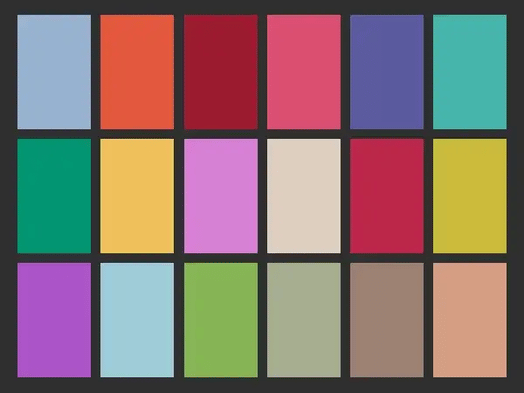
“What color should I paint my living room wall?” she says, laughing. Eiseman is executive director of the Pantone Color Institute, a branch of Pantone, AKA the company that developed a consistent language for how designers and manufacturers up and down the supply chain identify, create, and replicate thousands of shades of color.
“Even the CEO of the biggest corporation, you’re helping him with a color for a product that’s going to sell 5 billion units. And his last question is, ‘What color should I paint my living room?’”
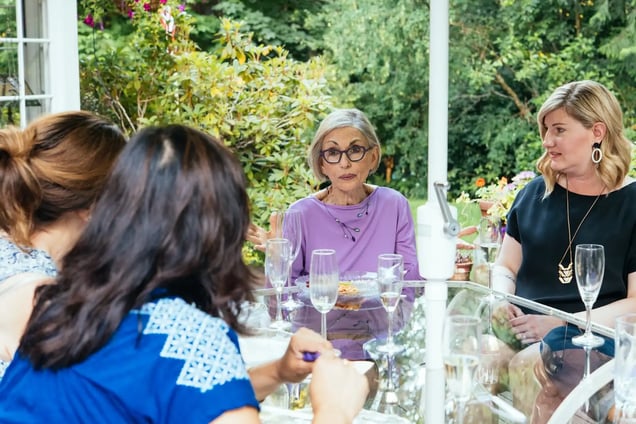
Leatrice Eiseman, center, at the Bainbridge Island Museum of Art. (Facebook)
Eiseman is the person to ask. She’s directed the institute since 1985. She’s been called the international guru of color. Her colleagues have called her “Ms. Color in America.”
Slight and bespectacled, with a bob that rivals Anna Wintour’s, Eiseman says picking a favorite color is like picking a favorite child: She can’t.
But she does have to choose. Once a year, she’s tasked with summing up the entire world, and all its complexities, in a single color.
Every year, she oversees the brand’s wildly successful Color of the Year campaign, unveiled in early December. She turns one color into a celebrity, and watches as consumers around the world pull out their wallets for the results.
Remember Y2K?
Back in 1994, trend forecaster and writer James Woudhuysen took a big swing. “Whoever controls color, controls the world,” he wrote in Marketing magazine. That was before the era of internet dominance, but you get the idea.
As the ’90s pressed on, uncertainty about approaching the new millennium grew. Around the Pantone office in Carlstadt, New Jersey, people began to talk. What if the clocks stopped? What if our digital devices died? What if the world ended?
What if, Pantone’s CEO mused, they could give people something to feel hopeful about? He asked Eiseman to pick a color that would represent the new millennium.
Color, Eiseman thought, could be a source of joy in uncertain times. It also, according to market research, has serious purchasing power when it comes to what consumers decide to buy.
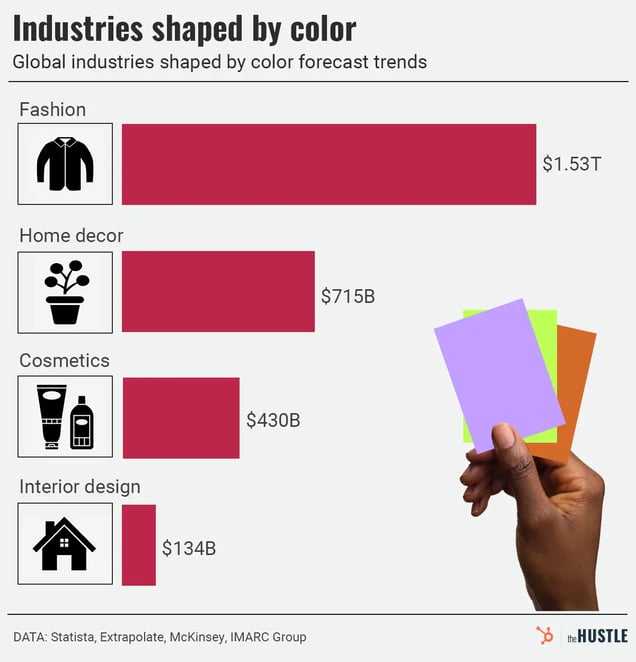
The Hustle
As has since been immortalized in the words of Miranda Priestly in The Devil Wears Prada, Eiseman chose cerulean, a sky blue.
“No matter where you live, everyone looks forward to seeing a beautiful blue sky,” she says.
They announced their selection. And the campaign exploded, making headlines across the globe and solidifying Pantone’s hold on public perception as the international color authority.
“It was like we had a tiger by the tail,” she says. “I said, ‘This is something we need to revisit every year.’ There was so much interest; it really amazed us.”
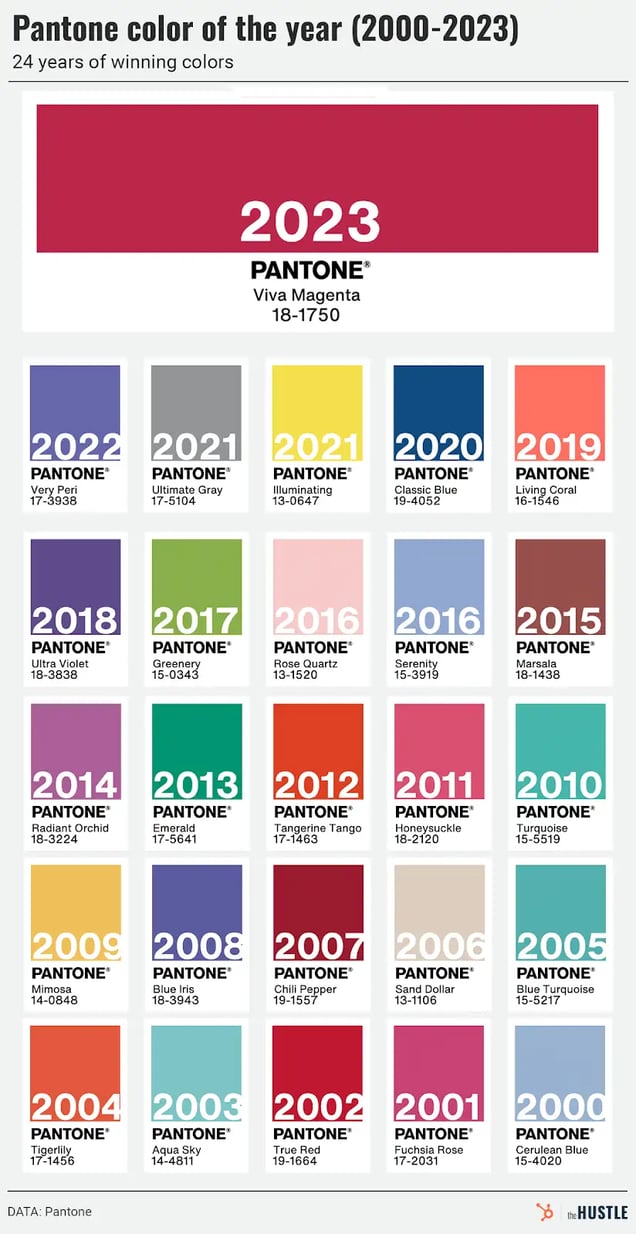
The Hustle
It also helped turn the company from a design darling to a household name. Most professionals knew the company, but the average consumer didn’t.
“If you said Pantone, they’d say, ‘Oh yeah, that’s a shampoo, right?’ Or, ‘Oh, it’s that good Italian bread,’” Eiseman says. “They just didn’t know what Pantone was until the Color of the Year started to get so much attention.”
The company doesn’t always get it right — it was criticized for choosing tone-deaf Living Coral in 2019, as reefs around the world faced unprecedented decay. A team of designers in Australia launched a viral counter-campaign calling the company’s choice “downright irresponsible,” and suggesting Bleached Coral instead.
Pantone has also been criticized for adding to the waste of industries like fast fashion. How big could the market for Emerald bedsheets or Serenity lipstick possibly be?
Still, over the last 25 years, the campaign has developed a propulsive life of its own. It’s been copied, partnered, styled, and covered into cultural dominance.
The birth of a lifestyle brand
Eiseman grew up in a row house in Baltimore, with a mother who she calls “an absolute demon with a paintbrush.” Every spring, her mom would repaint the entire house, piano included. (Once, she painted the broiler a pistachio green and nearly burned the house down when she plugged it back in.)
Eiseman was allowed to pick her own colors for her bedroom: She went with red and black. It was a sensibility she’d bring to her longtime home on Bainbridge Island, a 35-minute ferry ride from Seattle, where she painted her restored farmhouse a burnished shade of Rosewood.
In 1983, she published her first book, Alive with Color, a mix of color psychology, theory, and whimsy. The book caught the attention of a man named Lawrence Hebert, and he called her up. Hebert was a chemist who owned a printing company called Pantone.
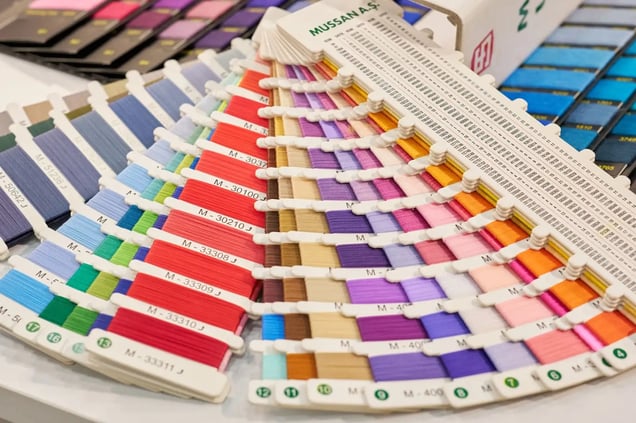
Color swatches. (Ferda Demir/Getty Images)
He hired her as a consultant, and she’s led the Pantone Color Institute ever since, a role she’s held for 37 years.
Pantone began as a biochemical company, developing inks and an alphanumeric system that ensured a textile mill in Italy would understand what a designer in New York meant when they said “cobalt blue.”
In essence, it still is, its chemists mixing paints and inks in its lab in New Jersey to produce swatch books it sells to brands, designers, and manufacturers for up to $9k, though the company has also added forecasting, publishing, licensing, and consulting to its oeuvre.
Eiseman’s duties involve giving names meant to evoke emotion to more than 2k of Pantone’s 10k color swatches, like Marsala (a burgundy inspired by the fortified wines of Sicily) or Tangerine Tango, which she named after an Argentine tango dancer’s necklace.
She also helps companies develop signature branding and colors, including:
- Tiffany blue (Pantone #1837)
- Hermes orange (Pantone #1448)
- Louboutin red (Pantone #18-1663 TPX)
(In the early 2010s, she gave some colors named in the ’80s a revamp. One shade of olive brown, simply called Drab, was reborn as Cumin.)
To select the Color of the Year, she travels the world, meeting an international cabal of uber-observers — designers, trend forecasters, and cultural detectives tapped into what the world will want to buy in the coming years.
Predicting the future of color lies in constant analysis. They examine what’s coming down runways, what new paintings are hanging on museum walls, what palettes are dominating animated children’s films in production, what sporting events are coming up, and even what themes are dominating discussions on TikTok.
Thanks to a series of powerful brand partnerships, and the tipoffs that come with them, the color of the year has become a self-fulfilling prophecy.
Last year, Motorola, Cariuma, Hydrow, and Art Basel Miami launched products (a phone, sneakers, a rowing machine, a public art exhibit called the “Magentaverse,” respectively) in Viva Magenta, the 2023 Color of the Year, as part of, and to reinforce, Pantone’s announcement.
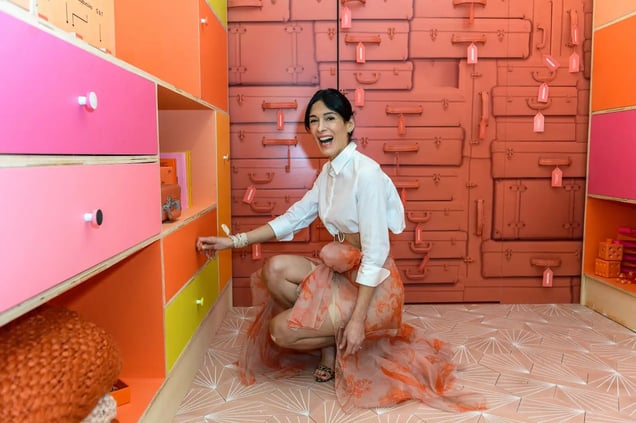
A Pantone Pantry at the 2018 Art Basel in Miami Beach. (Jason Koerner/Getty Images)
But the campaign has done even more than that. It has helped the company, once at risk of fading into irrelevance as the print industry struggled, reinvent itself.
Pantone launched a brand, Pantone Lifestyle, that reportedly makes up ~15% of the company’s business by selling mugs, notebooks, keychains, umbrellas, folding chairs, and hip flasks, among other products, styled to resemble the company’s swatches. (The company, a subsidiary of X-Rite, was acquired in 2007 for $180m, but doesn’t share other financial information.)
The company has helped create tea that changes color, a swatch-inspired hotel in Belgium, and even a Monaco cafe that serves Pistachio Green eclairs wrapped in Pantone swatches.
One of its more heartwarming manifestations? A company in Japan created a week’s worth of hospital scrubs in Pantone-licensed colors, to help long-term care patients mark the passage of time.
Culture detectives
Today, color is big business. Global trend consultancies like Pantone and WGSN release reports on what consumers will want to buy in two, three, and four years from now. WGSN recently published a study that said 98% of all buyers’ decisions are informed by color, a stat in whose certainty they certainly have a stake.
Color predictions are getting earlier and earlier — this past May, WGSN announced its Color of the Year for 2025, a broody blue-violet called Future Dusk. But announce too early, and you risk missing the moment: Pantone’s timing works because it tees up holiday shopping and the season when we’re all casting our eyes to the year ahead.
Sensing opportunity, paint companies have followed suit. In 2006, Benjamin Moore launched its own color of the year campaign. A few years later, in response to customers asking what their color of the year would be, Sherwin-Williams did too.
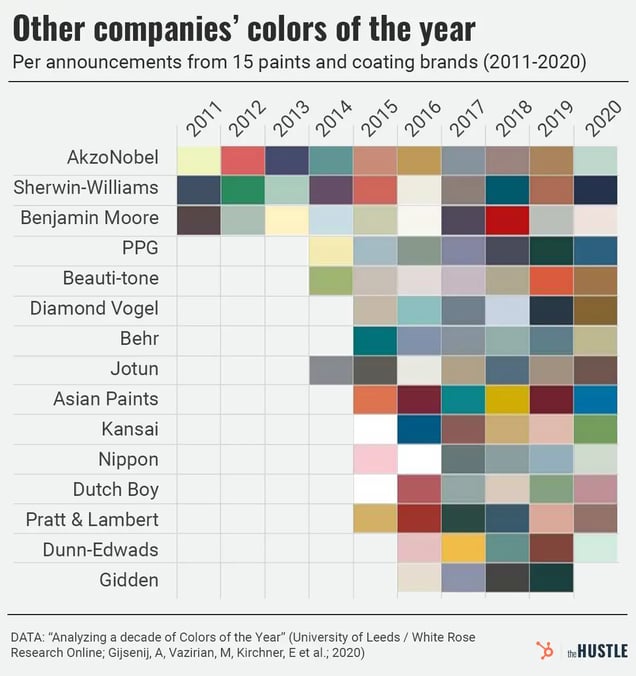
The Hustle
Once a color is selected, about a year before it’s announced, the next stages fall like dominoes. Stocks of paint chips are replenished. Locations are scouted; videos are shot. Immersive experiences are created. Paint cans are freshly mixed.
The color’s identity is kept a secret from as many people as possible for as long as possible. “It’s highly, highly confidential,” says Hannah Yeo, manager of color development and marketing at Benjamin Moore. “There’s a whole timeline of which people need to know and when.”
In the midst of the anticipation, staffers have taken to calling launch day “Christmas morning.”
Maximizing the impact pays off. Since the company’s 2024 announcement a month ago, sales of its chosen Blue Nova shade are up 400%.
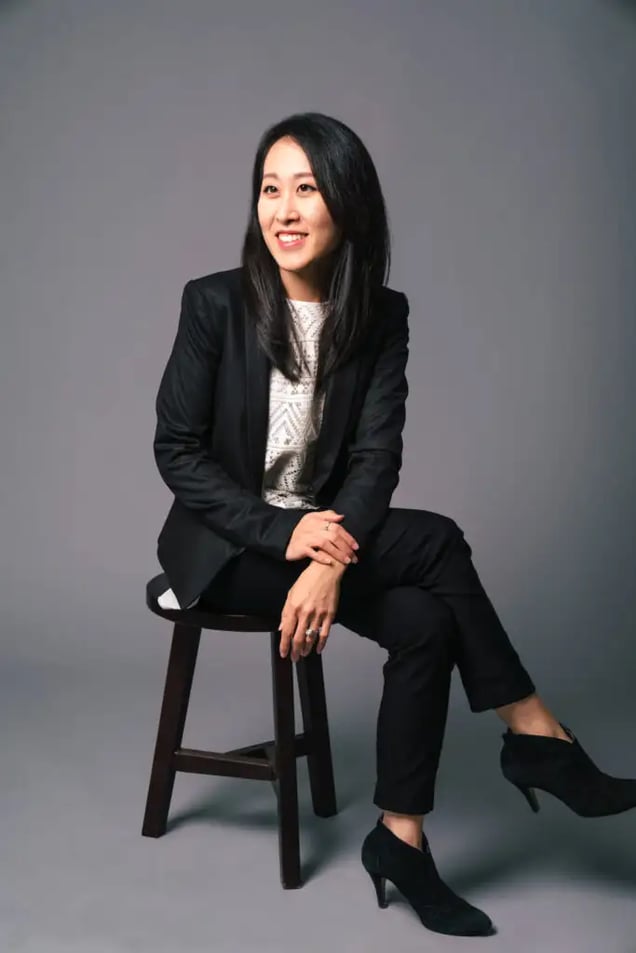
According to Benjamin Moore’s Hannah Yeo, discussions around the company’s Color of the Year selection can get, um, colorful. (via Benjamin Moore)
Sales at Sherwin-Williams also see a boost from its campaign. Sue Wadden, who oversees the selection as director of color marketing, uses paint chips as one of her success metrics. On average, she says, the company sees a 30% spike in color chip orders after their Color of the Year is announced.
“And we know that if people are ordering chips, chances are they’re going to buy some paint,” she says.
Wadden’s mission in life, she says, is to ensure people don’t have only white walls. If one of her selections, like last year’s controversial Redend Point, sparks a conversation or inspires someone, she considers that a win.
For Pantone, the stakes are higher.
“I admire the folks at Pantone — that’s a tough job,” Wadden says. “If people don’t like what they pick, then that affects people’s sales across industries. That’s hard.”
One in every color
Eiseman, in her kaleidoscopic world, doesn’t mind.
Two years ago, at 88 years old, Leatrice and her husband Herb moved to Tucson, in part to be closer to her daughter Beatrice, who works as her associate. Gone are the warm yellow walls she’d painted in her Bainbridge Island home to mimic sunlight, replaced by the actual sun.
Now, she works out of a converted RV garage, the neutral gray walls and floors ideal for making colors pop. Outside, on a patio with three palm trees, she watches the desert sunsets.
A few months ago, Eiseman walked into her bedroom to an all-too-familiar scene — her glasses, gnarled on the floor. Her new puppy had chewed through the frames she’d left on the bed.
When her daughter mentioned taking her car into the shop, Eiseman got an idea. Her new frames were no longer available in the color she wanted, and she’d already tried painting them with nail polish.
She brought them in with the car, and handed the mechanic a Pantone swatch. A week and $25 later, she had frames in Viva Magenta, 2023’s Color of the Year. “I wound up with an exclusive pair,” she says.
And, of course, she plans to go back to the same guy with this year’s color, after it’s announced the first week of December. “I’m going to ask him to take whatever frames I get and make sure that I have the exact color of the year,” she says.
She’ll need one in every color, after all.

